Abstract
In ecological systems, the hydra effect is an increase in population size caused by an increase in mortality. This seemingly counterintuitive effect has been observed in several populations, including fish, blowflies, snails and plants, and has been modeled in both continuous and discrete time. A similar effect induced by disease has recently been observed empirically. Here we present theoretical and simulation results for an infectious disease-induced hydra effect, namely conditions under which the total population size, composed of those that are infectious as well as those that are susceptible, at an endemic equilibrium is greater than the population size at the disease-free equilibrium. (For an endemic k-cycle, this can be similarly defined using the average population.) We find this disease-induced hydra effect occurs when the intra-specific competition is strong and disease infection sufficiently inhibits the reproductive output of infected individuals. For our continuous time model, we give a necessary and sufficient condition for a disease-induced hydra effect. This condition requires overcompensatory recruitment. With a discrete time model, we show there is no disease-induced hydra effect without overcompensatory recruitment. We illustrate by simulations that a disease-induced hydra effect may occur with Ricker recruitment when the endemic system converges to either a fixed equilibrium or a 2-cycle.





Similar content being viewed by others
References
Abrams PA (2009) When does greater mortality increase population size? The long history and diverse mechanisms underlying the hydra effect. Ecol Lett 12:462–474
Abrams PA, Matsuda H (2005) The effect of adaptive change in the prey on the dynamics of an exploited predator population. Can J Fish Aquat Sci 62:758–766
Allen LJS, van den Driessche P (2008) The basic reproduction number in some discrete-time epidemic models. J Differ Equ Appl 14:1127–1147
Buckley YM, Hinz HL, Matthies D, Rees M (2001) Interactions between density-dependent processes, population dynamics and control of an invasive plant species, tripleurospermum perforatum (scentless chamomile). Ecol Lett 4:551–558
Cortez MH (2016) Hydra effects in discrete-time models of stable communities. J Theor Biol 411:59–67
Cortez MH, Abrams PA (2016) Hydra effects in stable communities and their implications for system dynamics. Ecology 97:1135–1145
dos Anjos L, Costa MIDS, Almeida RC (2020) Characterizing the existence of hydra effect in spatial predator-prey models and the influence of functional response types and species dispersal. Ecol Modell 428:109109
Liz E, Ruiz-Herrera A (2012) The hydra effect, bubbles, and chaos in a simple discrete population model with constant effort harvesting. J Math Biol 65:997–1016
Moe SJ, Stenseth NC, Smith RH (2002) Density-dependent compensation in blowfly populations give indirectly positive effects of a toxicant. Ecology 83:1597–1603
Penczykowski RM, Hall SR, Shocket MS, Ochs JH, Lemanski BCP, Sundar H, Duffy MA (2021) Virulent disease epidemics can increase host density by depressing foraging of hosts. Am Nat. https://doi.org/10.1086/717175 (to appear)
Preston DL, Sauer EL (2020) Infection pathology and competition mediate host biomass overcompensation from disease. Wiley Online Library
Ricker WE (1954) Stock and recruitment. J Fish Res Board Can 11:559–623
Schröder A, Persson L, De Roos AM (2009) Culling experiments demonstrate size-class specific biomass increases with mortality. Proc Nat Acad Sci 106:2671–2676
Seno H (2008) Paradox in discrete single species population dynamics with harvesting/thinning. Math Biosci 214:63–69
Sieber M, Hilker FM (2012) The hydra effect in predator-prey models. J Math Biol 64:341–360
van den Driessche P, Yakubu A-A (2019) Demographic population cycles and R0 in discrete-time epidemic models. J Biol Dyn 13:179–200
Zipkin EF, Sullivan PJ, Cooch EG, Kraft CE, Shuter BJ, Weidel BC (2008) Overcompensatory response of a smallmouth bass (Micropterus dolomieu) population to harvest: release from competition? Can J Fish Aquat Sci 65:2279–2292
Zipkin EF, Kraft CE, Cooch EG, Sullivan PJ (2009) When can efforts to control nuisance and invasive species backfire? Ecol Appl 19:1585–1595
Acknowledgements
The research of JM and PvdD is partially supported by NSERC Discovery Grants. We thank the anonymous reviewers for their many constructive comments.
Author information
Authors and Affiliations
Corresponding author
Additional information
Publisher's Note
Springer Nature remains neutral with regard to jurisdictional claims in published maps and institutional affiliations.
Appendix: Proof of Theorem 4
Appendix: Proof of Theorem 4
1.1 Existence of Endemic Equilibrium (EE)
From (11), the endemic equilibrium \((S^*, I^*)\) must satisfy
This requires that
Substituting (14) into (12) gives that \(S^{*}\) must be a positive root of
For the EE to exist, L(S) must be defined, and (14) must hold, and thus \(d<f(S)<1\). In addition \(S>0\). Let
Then, the domain of L(S) is \([\ell , S_{{\text {DFE}}}]\).
To show the existence of an EE for \({\mathcal {R}}_0 >1\), we show that L(S) has opposite signs near the two endpoints of its domain. Firstly, note that \(L(S_{{\text {DFE}}})=0\). Furthermore,
Differentiating,
Thus, if \({\mathcal {R}}_0> 1\), then \(L'(S_{{\text {DFE}}})<0\). There then exists an \(\varepsilon >0\) such that \(L(S_{{\text {DFE}}}-\varepsilon )>0\). Secondly, \(L(\ell )<0\). Thus, L(S) must have a positive root in the domain \((\ell , S_{{\text {DFE}}})\), i.e., there must exist an EE if \({\mathcal {R}}_0>1\).
1.2 Uniqueness of the Endemic Equilibrium
To show that the EE is unique, we show that \(L''(S)<0\) for \(S\le S_{{\text {DFE}}}\).
Since \(f''(S)>0\) and \(f(S)<1\), the first term of \(L''(S)\) is negative. The second term is \(g''(S)<0\) where \(g(S) = Sf(S)\). Thus, \(L''(S)<0\), i.e., L(S) is concave down, and thus L(S) cannot have more than two roots. Since \(S_{{\text {DFE}}}\) is already a root, this guarantees the uniqueness of the EE. \(\square \)
Rights and permissions
About this article
Cite this article
Jaramillo, J.M., Ma, J., van den Driessche, P. et al. Disease-Induced Hydra Effect with Overcompensatory Recruitment. Bull Math Biol 84, 17 (2022). https://doi.org/10.1007/s11538-021-00975-4
Received:
Accepted:
Published:
DOI: https://doi.org/10.1007/s11538-021-00975-4




